The Importance of Human Resource Management Policies to Success
VerifiedAdded on 2021/11/19
|8
|1821
|173
Report
AI Summary
This research paper investigates the crucial role of Human Resource Management (HRM) policies in fostering organizational success. The study delves into the multifaceted functions of HRM, including job analysis, recruitment, training, and performance evaluation, highlighting their impact on organizational management. The literature review explores the existing body of knowledge, referencing key studies that examine the correlation between HRM practices and organizational outcomes, such as competitive sustainability and employee retention. The research poses questions regarding the connection between HRM policies and organizational success and employs both the Universalist and contingency models to provide a theoretical framework. The methodology involves a survey procedure targeting HR managers, utilizing Likert scales and exploratory factor analysis. The paper acknowledges potential research limitations, such as cost and potential bias, while emphasizing the significance of effective HRM in the modern business landscape.
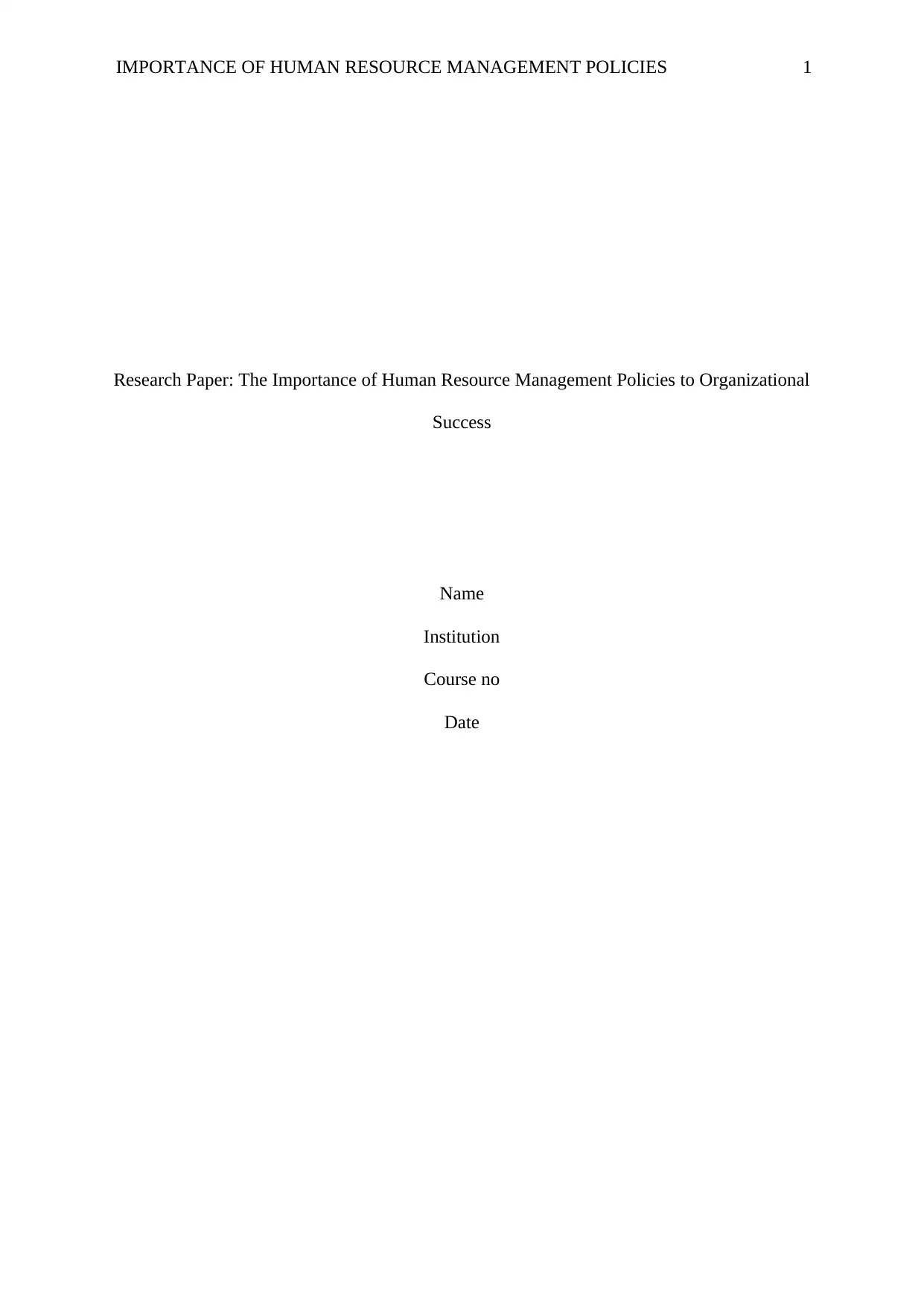
IMPORTANCE OF HUMAN RESOURCE MANAGEMENT POLICIES 1
Research Paper: The Importance of Human Resource Management Policies to Organizational
Success
Name
Institution
Course no
Date
Research Paper: The Importance of Human Resource Management Policies to Organizational
Success
Name
Institution
Course no
Date
Paraphrase This Document
Need a fresh take? Get an instant paraphrase of this document with our AI Paraphraser
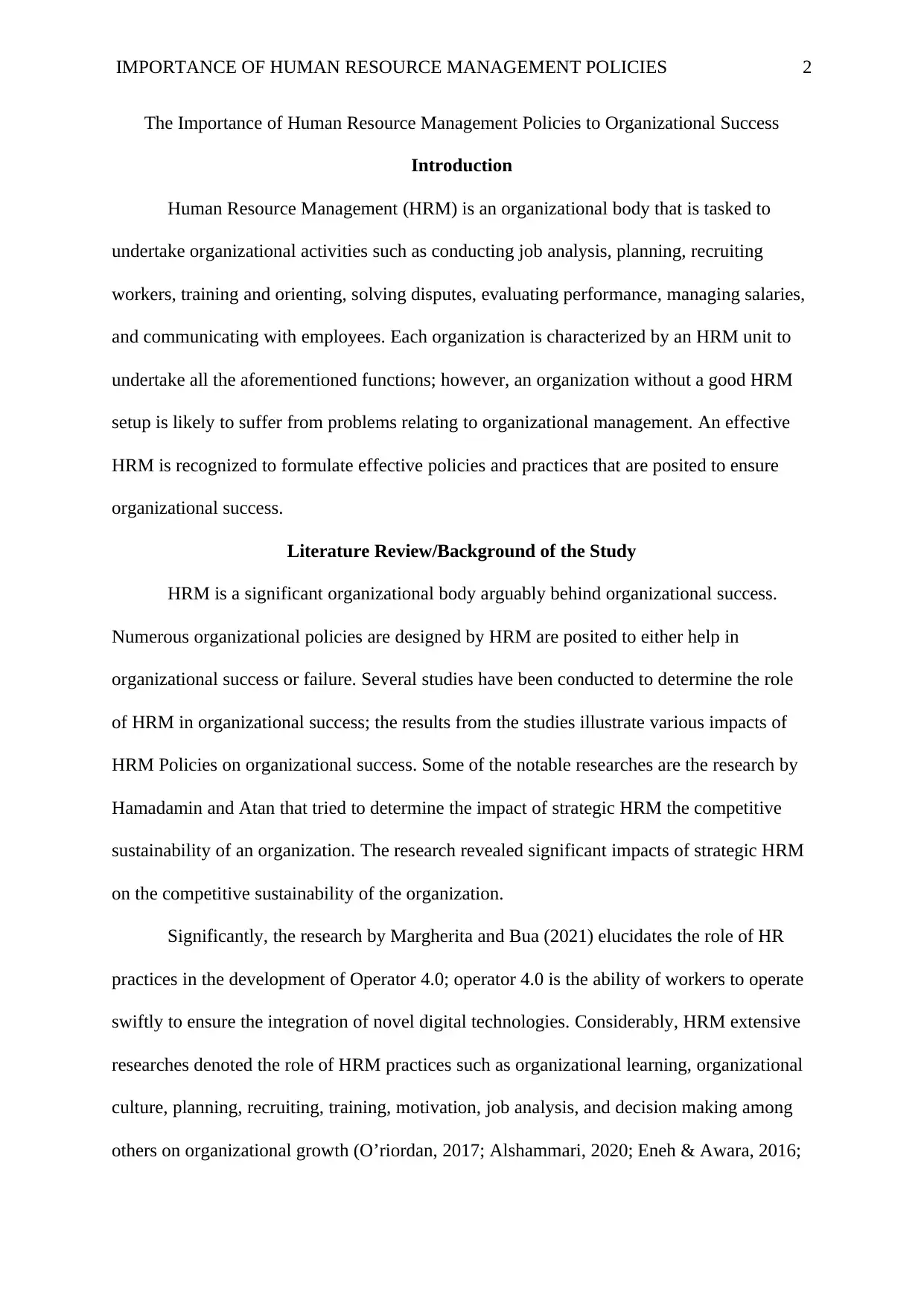
IMPORTANCE OF HUMAN RESOURCE MANAGEMENT POLICIES 2
The Importance of Human Resource Management Policies to Organizational Success
Introduction
Human Resource Management (HRM) is an organizational body that is tasked to
undertake organizational activities such as conducting job analysis, planning, recruiting
workers, training and orienting, solving disputes, evaluating performance, managing salaries,
and communicating with employees. Each organization is characterized by an HRM unit to
undertake all the aforementioned functions; however, an organization without a good HRM
setup is likely to suffer from problems relating to organizational management. An effective
HRM is recognized to formulate effective policies and practices that are posited to ensure
organizational success.
Literature Review/Background of the Study
HRM is a significant organizational body arguably behind organizational success.
Numerous organizational policies are designed by HRM are posited to either help in
organizational success or failure. Several studies have been conducted to determine the role
of HRM in organizational success; the results from the studies illustrate various impacts of
HRM Policies on organizational success. Some of the notable researches are the research by
Hamadamin and Atan that tried to determine the impact of strategic HRM the competitive
sustainability of an organization. The research revealed significant impacts of strategic HRM
on the competitive sustainability of the organization.
Significantly, the research by Margherita and Bua (2021) elucidates the role of HR
practices in the development of Operator 4.0; operator 4.0 is the ability of workers to operate
swiftly to ensure the integration of novel digital technologies. Considerably, HRM extensive
researches denoted the role of HRM practices such as organizational learning, organizational
culture, planning, recruiting, training, motivation, job analysis, and decision making among
others on organizational growth (O’riordan, 2017; Alshammari, 2020; Eneh & Awara, 2016;
The Importance of Human Resource Management Policies to Organizational Success
Introduction
Human Resource Management (HRM) is an organizational body that is tasked to
undertake organizational activities such as conducting job analysis, planning, recruiting
workers, training and orienting, solving disputes, evaluating performance, managing salaries,
and communicating with employees. Each organization is characterized by an HRM unit to
undertake all the aforementioned functions; however, an organization without a good HRM
setup is likely to suffer from problems relating to organizational management. An effective
HRM is recognized to formulate effective policies and practices that are posited to ensure
organizational success.
Literature Review/Background of the Study
HRM is a significant organizational body arguably behind organizational success.
Numerous organizational policies are designed by HRM are posited to either help in
organizational success or failure. Several studies have been conducted to determine the role
of HRM in organizational success; the results from the studies illustrate various impacts of
HRM Policies on organizational success. Some of the notable researches are the research by
Hamadamin and Atan that tried to determine the impact of strategic HRM the competitive
sustainability of an organization. The research revealed significant impacts of strategic HRM
on the competitive sustainability of the organization.
Significantly, the research by Margherita and Bua (2021) elucidates the role of HR
practices in the development of Operator 4.0; operator 4.0 is the ability of workers to operate
swiftly to ensure the integration of novel digital technologies. Considerably, HRM extensive
researches denoted the role of HRM practices such as organizational learning, organizational
culture, planning, recruiting, training, motivation, job analysis, and decision making among
others on organizational growth (O’riordan, 2017; Alshammari, 2020; Eneh & Awara, 2016;
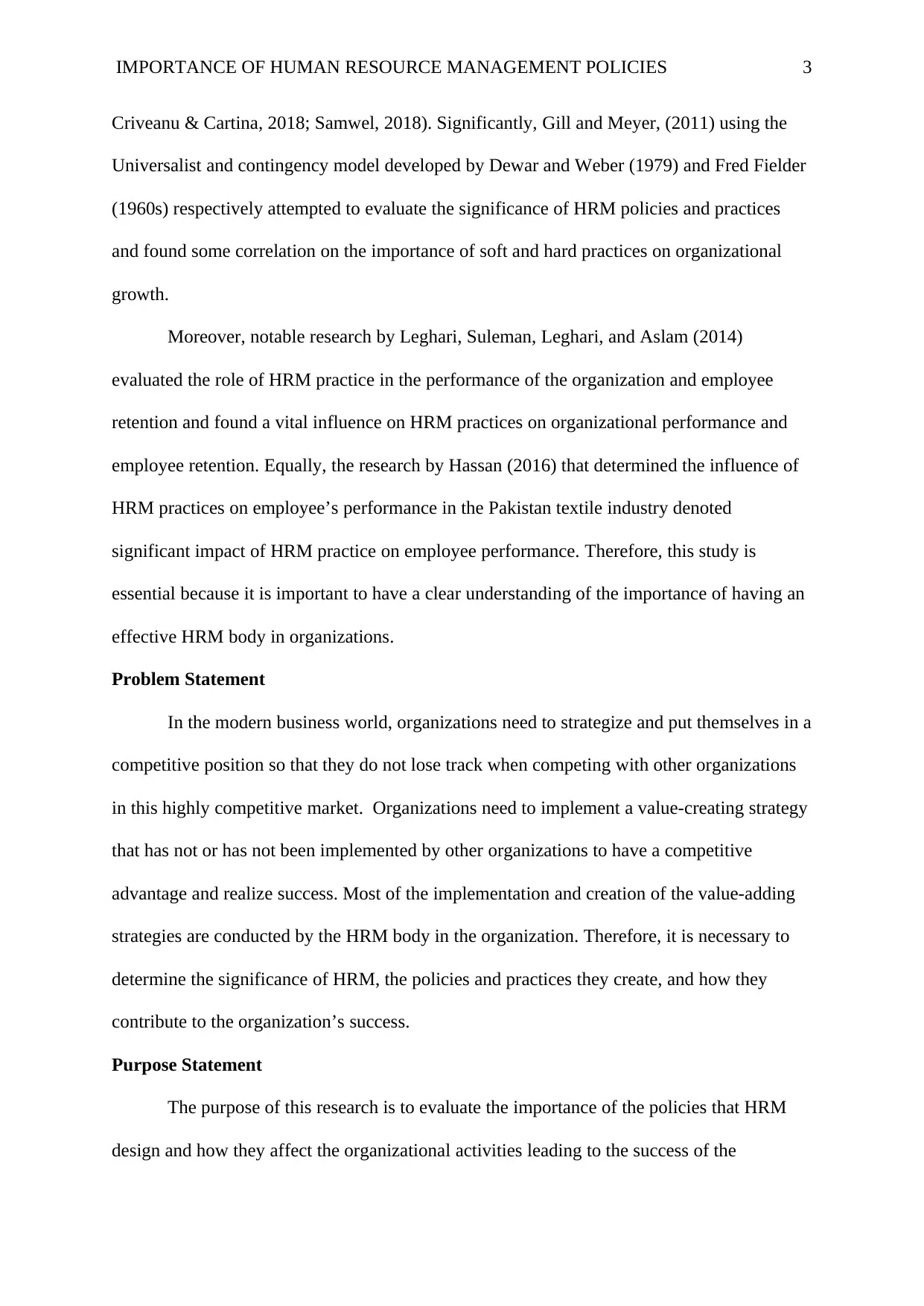
IMPORTANCE OF HUMAN RESOURCE MANAGEMENT POLICIES 3
Criveanu & Cartina, 2018; Samwel, 2018). Significantly, Gill and Meyer, (2011) using the
Universalist and contingency model developed by Dewar and Weber (1979) and Fred Fielder
(1960s) respectively attempted to evaluate the significance of HRM policies and practices
and found some correlation on the importance of soft and hard practices on organizational
growth.
Moreover, notable research by Leghari, Suleman, Leghari, and Aslam (2014)
evaluated the role of HRM practice in the performance of the organization and employee
retention and found a vital influence on HRM practices on organizational performance and
employee retention. Equally, the research by Hassan (2016) that determined the influence of
HRM practices on employee’s performance in the Pakistan textile industry denoted
significant impact of HRM practice on employee performance. Therefore, this study is
essential because it is important to have a clear understanding of the importance of having an
effective HRM body in organizations.
Problem Statement
In the modern business world, organizations need to strategize and put themselves in a
competitive position so that they do not lose track when competing with other organizations
in this highly competitive market. Organizations need to implement a value-creating strategy
that has not or has not been implemented by other organizations to have a competitive
advantage and realize success. Most of the implementation and creation of the value-adding
strategies are conducted by the HRM body in the organization. Therefore, it is necessary to
determine the significance of HRM, the policies and practices they create, and how they
contribute to the organization’s success.
Purpose Statement
The purpose of this research is to evaluate the importance of the policies that HRM
design and how they affect the organizational activities leading to the success of the
Criveanu & Cartina, 2018; Samwel, 2018). Significantly, Gill and Meyer, (2011) using the
Universalist and contingency model developed by Dewar and Weber (1979) and Fred Fielder
(1960s) respectively attempted to evaluate the significance of HRM policies and practices
and found some correlation on the importance of soft and hard practices on organizational
growth.
Moreover, notable research by Leghari, Suleman, Leghari, and Aslam (2014)
evaluated the role of HRM practice in the performance of the organization and employee
retention and found a vital influence on HRM practices on organizational performance and
employee retention. Equally, the research by Hassan (2016) that determined the influence of
HRM practices on employee’s performance in the Pakistan textile industry denoted
significant impact of HRM practice on employee performance. Therefore, this study is
essential because it is important to have a clear understanding of the importance of having an
effective HRM body in organizations.
Problem Statement
In the modern business world, organizations need to strategize and put themselves in a
competitive position so that they do not lose track when competing with other organizations
in this highly competitive market. Organizations need to implement a value-creating strategy
that has not or has not been implemented by other organizations to have a competitive
advantage and realize success. Most of the implementation and creation of the value-adding
strategies are conducted by the HRM body in the organization. Therefore, it is necessary to
determine the significance of HRM, the policies and practices they create, and how they
contribute to the organization’s success.
Purpose Statement
The purpose of this research is to evaluate the importance of the policies that HRM
design and how they affect the organizational activities leading to the success of the
⊘ This is a preview!⊘
Do you want full access?
Subscribe today to unlock all pages.

Trusted by 1+ million students worldwide
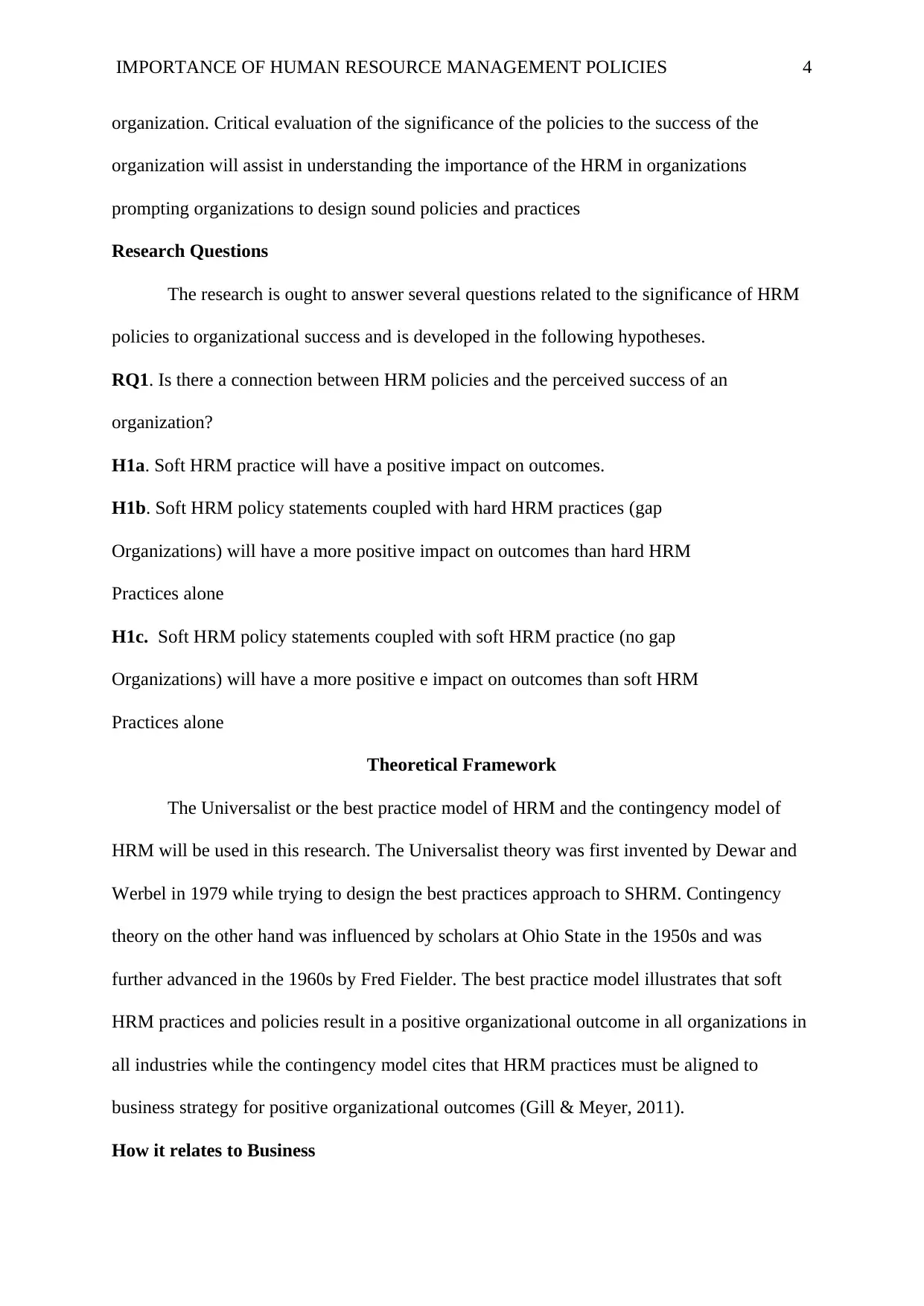
IMPORTANCE OF HUMAN RESOURCE MANAGEMENT POLICIES 4
organization. Critical evaluation of the significance of the policies to the success of the
organization will assist in understanding the importance of the HRM in organizations
prompting organizations to design sound policies and practices
Research Questions
The research is ought to answer several questions related to the significance of HRM
policies to organizational success and is developed in the following hypotheses.
RQ1. Is there a connection between HRM policies and the perceived success of an
organization?
H1a. Soft HRM practice will have a positive impact on outcomes.
H1b. Soft HRM policy statements coupled with hard HRM practices (gap
Organizations) will have a more positive impact on outcomes than hard HRM
Practices alone
H1c. Soft HRM policy statements coupled with soft HRM practice (no gap
Organizations) will have a more positive e impact on outcomes than soft HRM
Practices alone
Theoretical Framework
The Universalist or the best practice model of HRM and the contingency model of
HRM will be used in this research. The Universalist theory was first invented by Dewar and
Werbel in 1979 while trying to design the best practices approach to SHRM. Contingency
theory on the other hand was influenced by scholars at Ohio State in the 1950s and was
further advanced in the 1960s by Fred Fielder. The best practice model illustrates that soft
HRM practices and policies result in a positive organizational outcome in all organizations in
all industries while the contingency model cites that HRM practices must be aligned to
business strategy for positive organizational outcomes (Gill & Meyer, 2011).
How it relates to Business
organization. Critical evaluation of the significance of the policies to the success of the
organization will assist in understanding the importance of the HRM in organizations
prompting organizations to design sound policies and practices
Research Questions
The research is ought to answer several questions related to the significance of HRM
policies to organizational success and is developed in the following hypotheses.
RQ1. Is there a connection between HRM policies and the perceived success of an
organization?
H1a. Soft HRM practice will have a positive impact on outcomes.
H1b. Soft HRM policy statements coupled with hard HRM practices (gap
Organizations) will have a more positive impact on outcomes than hard HRM
Practices alone
H1c. Soft HRM policy statements coupled with soft HRM practice (no gap
Organizations) will have a more positive e impact on outcomes than soft HRM
Practices alone
Theoretical Framework
The Universalist or the best practice model of HRM and the contingency model of
HRM will be used in this research. The Universalist theory was first invented by Dewar and
Werbel in 1979 while trying to design the best practices approach to SHRM. Contingency
theory on the other hand was influenced by scholars at Ohio State in the 1950s and was
further advanced in the 1960s by Fred Fielder. The best practice model illustrates that soft
HRM practices and policies result in a positive organizational outcome in all organizations in
all industries while the contingency model cites that HRM practices must be aligned to
business strategy for positive organizational outcomes (Gill & Meyer, 2011).
How it relates to Business
Paraphrase This Document
Need a fresh take? Get an instant paraphrase of this document with our AI Paraphraser
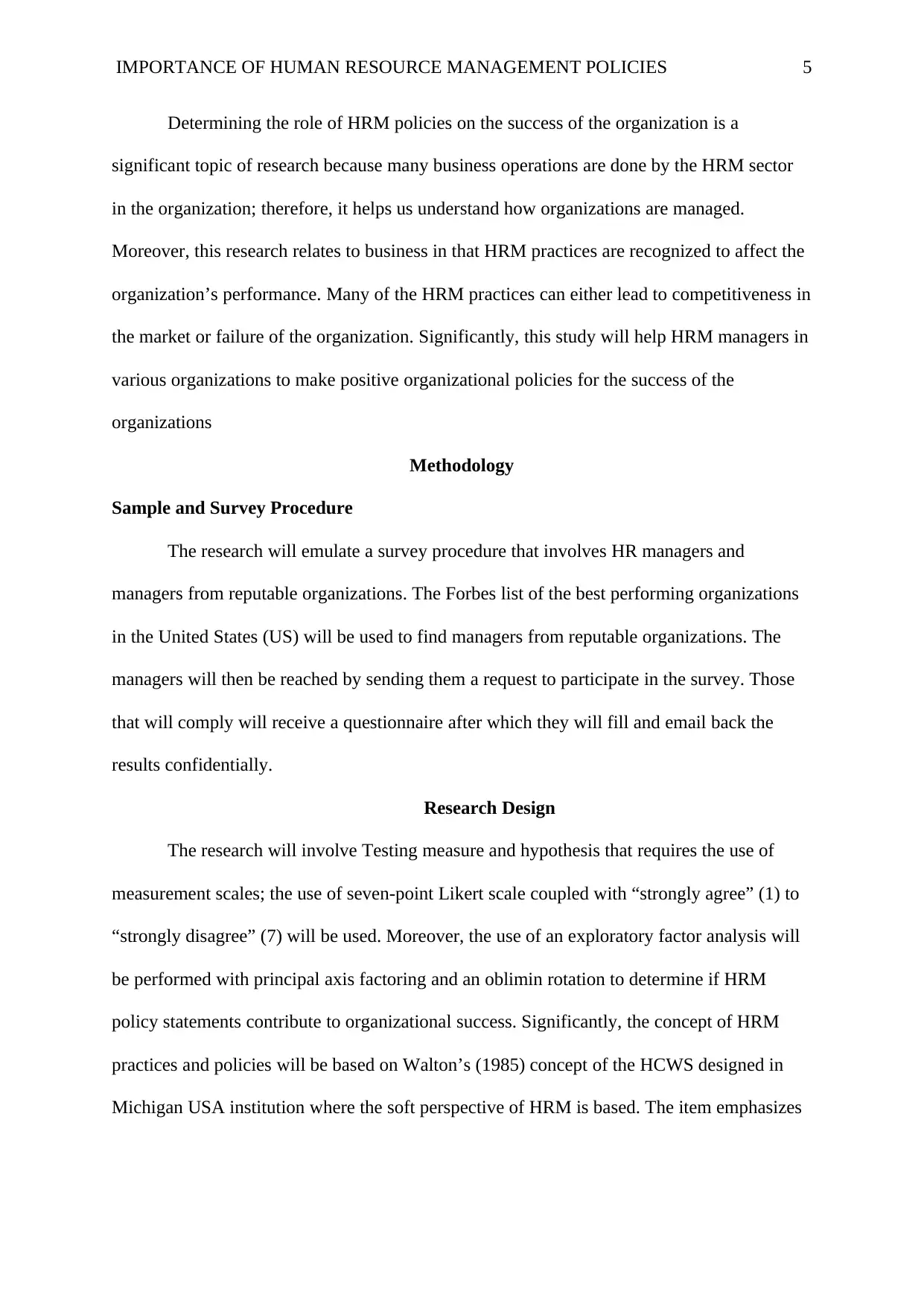
IMPORTANCE OF HUMAN RESOURCE MANAGEMENT POLICIES 5
Determining the role of HRM policies on the success of the organization is a
significant topic of research because many business operations are done by the HRM sector
in the organization; therefore, it helps us understand how organizations are managed.
Moreover, this research relates to business in that HRM practices are recognized to affect the
organization’s performance. Many of the HRM practices can either lead to competitiveness in
the market or failure of the organization. Significantly, this study will help HRM managers in
various organizations to make positive organizational policies for the success of the
organizations
Methodology
Sample and Survey Procedure
The research will emulate a survey procedure that involves HR managers and
managers from reputable organizations. The Forbes list of the best performing organizations
in the United States (US) will be used to find managers from reputable organizations. The
managers will then be reached by sending them a request to participate in the survey. Those
that will comply will receive a questionnaire after which they will fill and email back the
results confidentially.
Research Design
The research will involve Testing measure and hypothesis that requires the use of
measurement scales; the use of seven-point Likert scale coupled with “strongly agree” (1) to
“strongly disagree” (7) will be used. Moreover, the use of an exploratory factor analysis will
be performed with principal axis factoring and an oblimin rotation to determine if HRM
policy statements contribute to organizational success. Significantly, the concept of HRM
practices and policies will be based on Walton’s (1985) concept of the HCWS designed in
Michigan USA institution where the soft perspective of HRM is based. The item emphasizes
Determining the role of HRM policies on the success of the organization is a
significant topic of research because many business operations are done by the HRM sector
in the organization; therefore, it helps us understand how organizations are managed.
Moreover, this research relates to business in that HRM practices are recognized to affect the
organization’s performance. Many of the HRM practices can either lead to competitiveness in
the market or failure of the organization. Significantly, this study will help HRM managers in
various organizations to make positive organizational policies for the success of the
organizations
Methodology
Sample and Survey Procedure
The research will emulate a survey procedure that involves HR managers and
managers from reputable organizations. The Forbes list of the best performing organizations
in the United States (US) will be used to find managers from reputable organizations. The
managers will then be reached by sending them a request to participate in the survey. Those
that will comply will receive a questionnaire after which they will fill and email back the
results confidentially.
Research Design
The research will involve Testing measure and hypothesis that requires the use of
measurement scales; the use of seven-point Likert scale coupled with “strongly agree” (1) to
“strongly disagree” (7) will be used. Moreover, the use of an exploratory factor analysis will
be performed with principal axis factoring and an oblimin rotation to determine if HRM
policy statements contribute to organizational success. Significantly, the concept of HRM
practices and policies will be based on Walton’s (1985) concept of the HCWS designed in
Michigan USA institution where the soft perspective of HRM is based. The item emphasizes
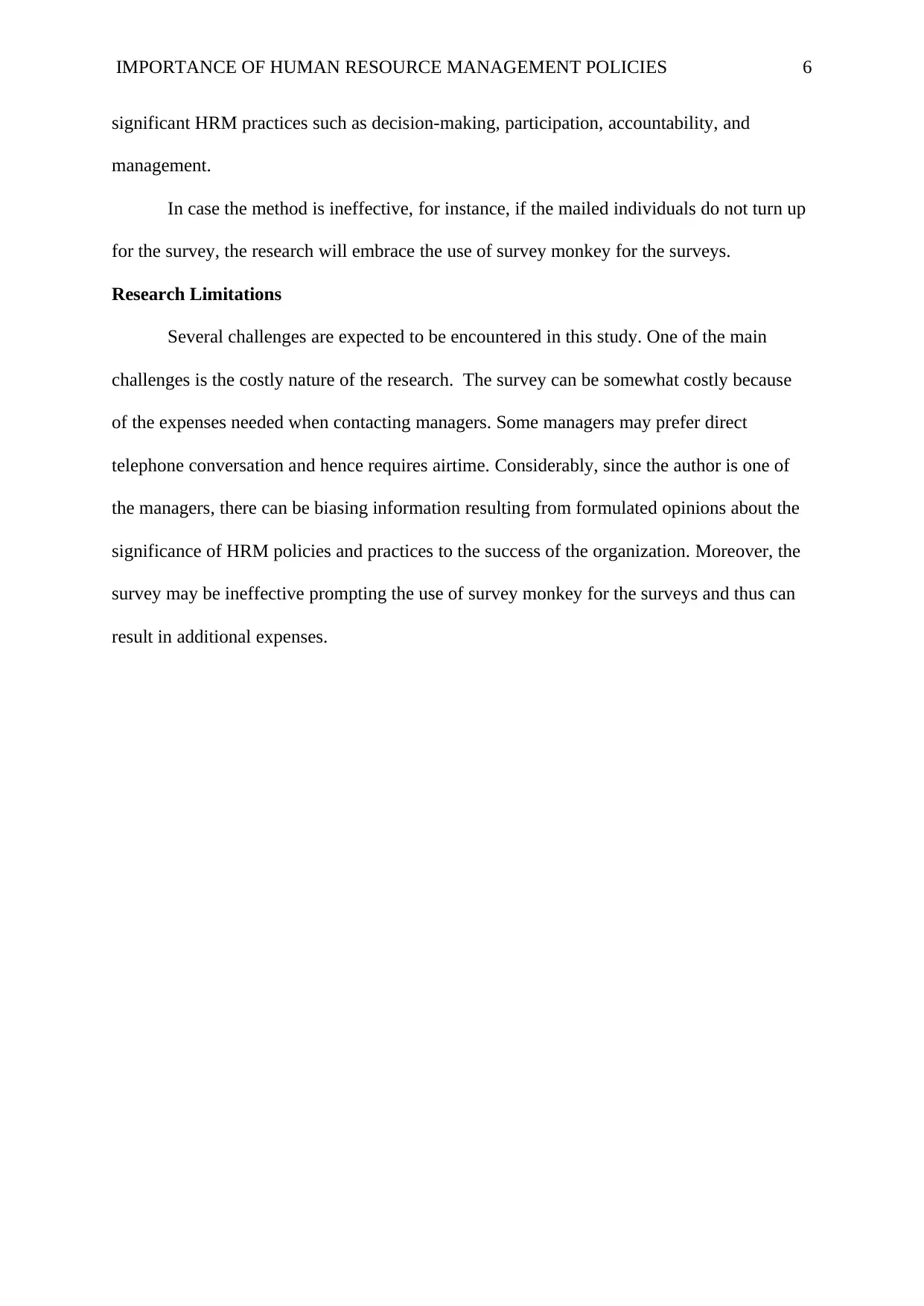
IMPORTANCE OF HUMAN RESOURCE MANAGEMENT POLICIES 6
significant HRM practices such as decision-making, participation, accountability, and
management.
In case the method is ineffective, for instance, if the mailed individuals do not turn up
for the survey, the research will embrace the use of survey monkey for the surveys.
Research Limitations
Several challenges are expected to be encountered in this study. One of the main
challenges is the costly nature of the research. The survey can be somewhat costly because
of the expenses needed when contacting managers. Some managers may prefer direct
telephone conversation and hence requires airtime. Considerably, since the author is one of
the managers, there can be biasing information resulting from formulated opinions about the
significance of HRM policies and practices to the success of the organization. Moreover, the
survey may be ineffective prompting the use of survey monkey for the surveys and thus can
result in additional expenses.
significant HRM practices such as decision-making, participation, accountability, and
management.
In case the method is ineffective, for instance, if the mailed individuals do not turn up
for the survey, the research will embrace the use of survey monkey for the surveys.
Research Limitations
Several challenges are expected to be encountered in this study. One of the main
challenges is the costly nature of the research. The survey can be somewhat costly because
of the expenses needed when contacting managers. Some managers may prefer direct
telephone conversation and hence requires airtime. Considerably, since the author is one of
the managers, there can be biasing information resulting from formulated opinions about the
significance of HRM policies and practices to the success of the organization. Moreover, the
survey may be ineffective prompting the use of survey monkey for the surveys and thus can
result in additional expenses.
⊘ This is a preview!⊘
Do you want full access?
Subscribe today to unlock all pages.

Trusted by 1+ million students worldwide
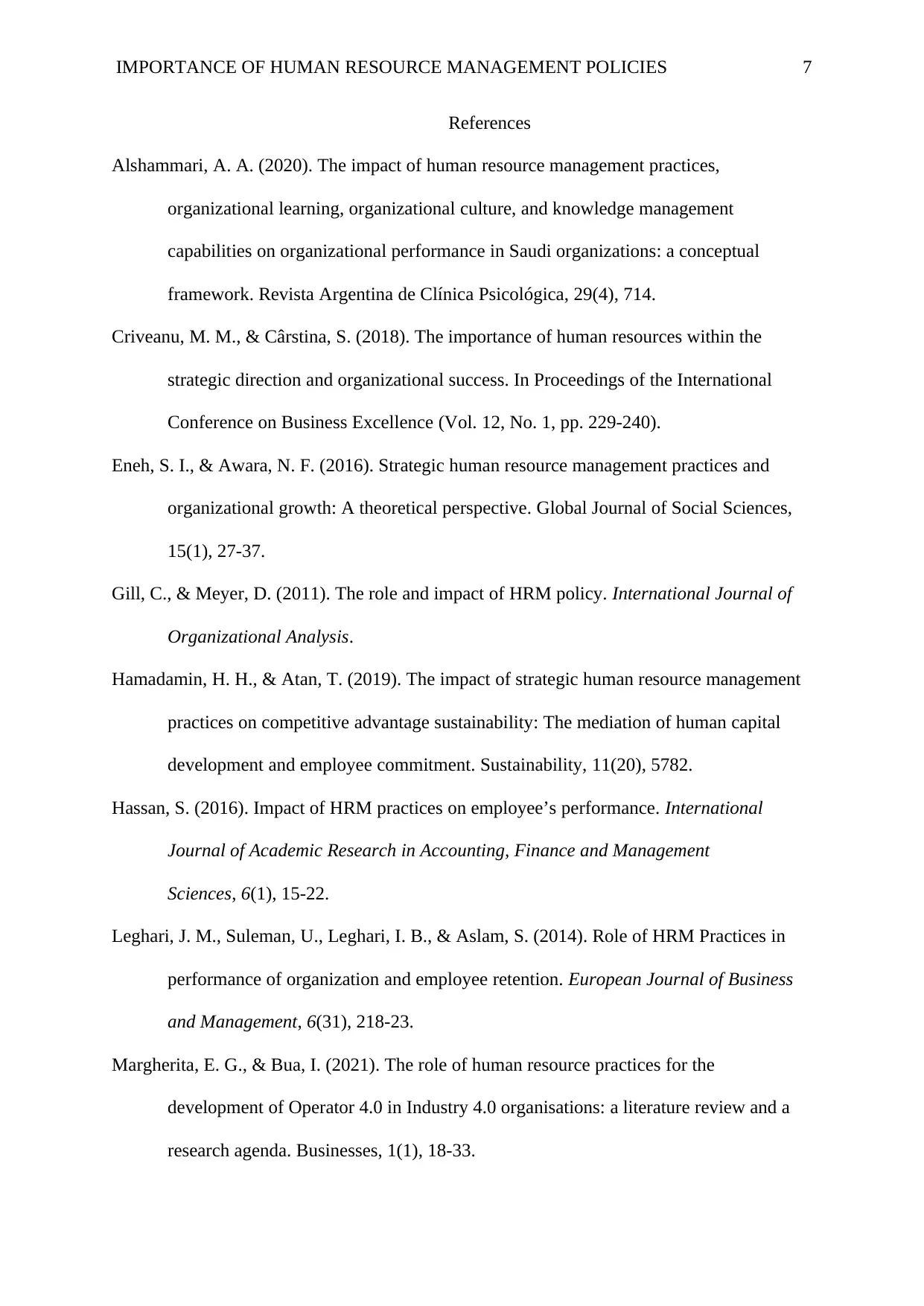
IMPORTANCE OF HUMAN RESOURCE MANAGEMENT POLICIES 7
References
Alshammari, A. A. (2020). The impact of human resource management practices,
organizational learning, organizational culture, and knowledge management
capabilities on organizational performance in Saudi organizations: a conceptual
framework. Revista Argentina de Clínica Psicológica, 29(4), 714.
Criveanu, M. M., & Cârstina, S. (2018). The importance of human resources within the
strategic direction and organizational success. In Proceedings of the International
Conference on Business Excellence (Vol. 12, No. 1, pp. 229-240).
Eneh, S. I., & Awara, N. F. (2016). Strategic human resource management practices and
organizational growth: A theoretical perspective. Global Journal of Social Sciences,
15(1), 27-37.
Gill, C., & Meyer, D. (2011). The role and impact of HRM policy. International Journal of
Organizational Analysis.
Hamadamin, H. H., & Atan, T. (2019). The impact of strategic human resource management
practices on competitive advantage sustainability: The mediation of human capital
development and employee commitment. Sustainability, 11(20), 5782.
Hassan, S. (2016). Impact of HRM practices on employee’s performance. International
Journal of Academic Research in Accounting, Finance and Management
Sciences, 6(1), 15-22.
Leghari, J. M., Suleman, U., Leghari, I. B., & Aslam, S. (2014). Role of HRM Practices in
performance of organization and employee retention. European Journal of Business
and Management, 6(31), 218-23.
Margherita, E. G., & Bua, I. (2021). The role of human resource practices for the
development of Operator 4.0 in Industry 4.0 organisations: a literature review and a
research agenda. Businesses, 1(1), 18-33.
References
Alshammari, A. A. (2020). The impact of human resource management practices,
organizational learning, organizational culture, and knowledge management
capabilities on organizational performance in Saudi organizations: a conceptual
framework. Revista Argentina de Clínica Psicológica, 29(4), 714.
Criveanu, M. M., & Cârstina, S. (2018). The importance of human resources within the
strategic direction and organizational success. In Proceedings of the International
Conference on Business Excellence (Vol. 12, No. 1, pp. 229-240).
Eneh, S. I., & Awara, N. F. (2016). Strategic human resource management practices and
organizational growth: A theoretical perspective. Global Journal of Social Sciences,
15(1), 27-37.
Gill, C., & Meyer, D. (2011). The role and impact of HRM policy. International Journal of
Organizational Analysis.
Hamadamin, H. H., & Atan, T. (2019). The impact of strategic human resource management
practices on competitive advantage sustainability: The mediation of human capital
development and employee commitment. Sustainability, 11(20), 5782.
Hassan, S. (2016). Impact of HRM practices on employee’s performance. International
Journal of Academic Research in Accounting, Finance and Management
Sciences, 6(1), 15-22.
Leghari, J. M., Suleman, U., Leghari, I. B., & Aslam, S. (2014). Role of HRM Practices in
performance of organization and employee retention. European Journal of Business
and Management, 6(31), 218-23.
Margherita, E. G., & Bua, I. (2021). The role of human resource practices for the
development of Operator 4.0 in Industry 4.0 organisations: a literature review and a
research agenda. Businesses, 1(1), 18-33.
Paraphrase This Document
Need a fresh take? Get an instant paraphrase of this document with our AI Paraphraser
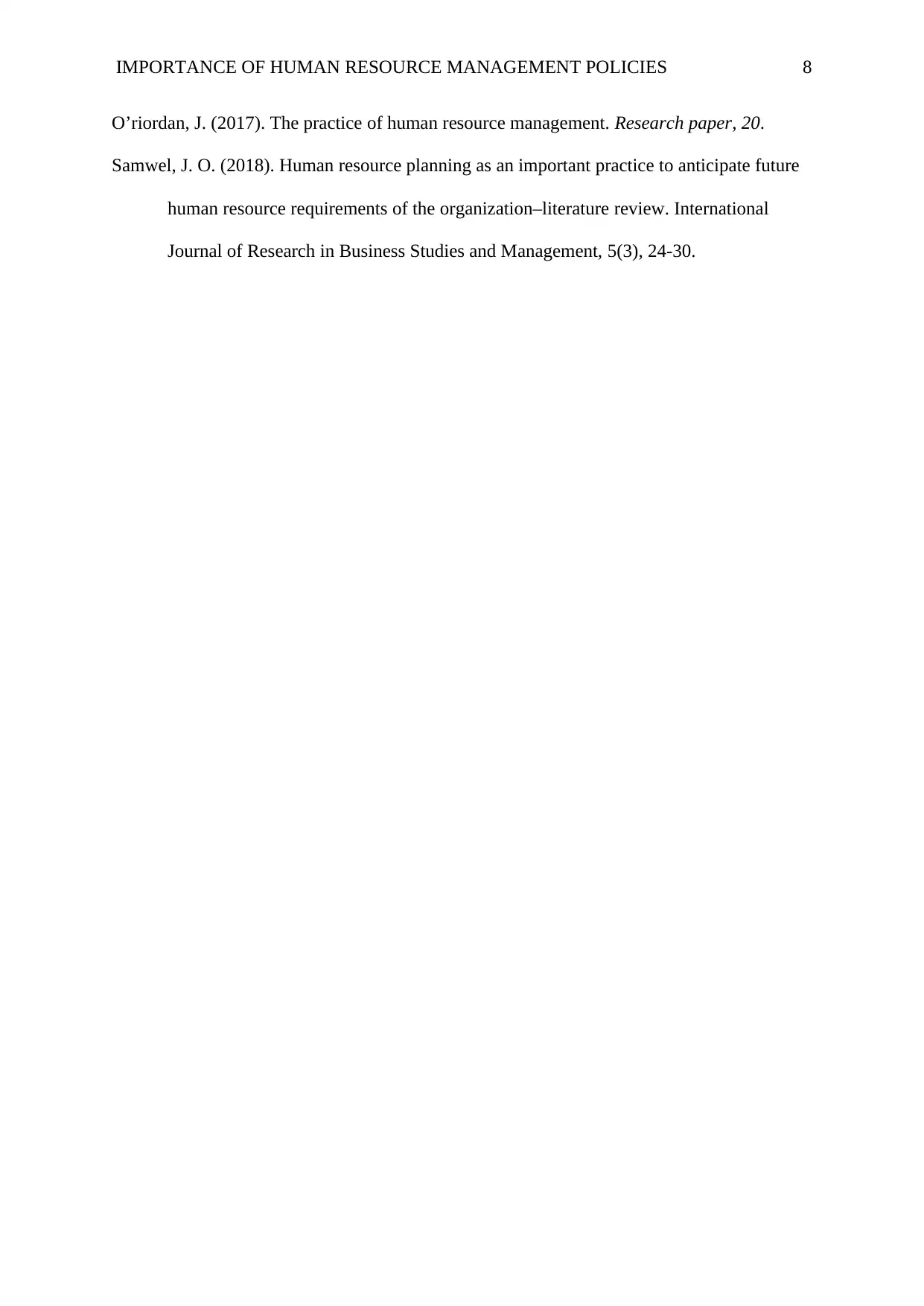
IMPORTANCE OF HUMAN RESOURCE MANAGEMENT POLICIES 8
O’riordan, J. (2017). The practice of human resource management. Research paper, 20.
Samwel, J. O. (2018). Human resource planning as an important practice to anticipate future
human resource requirements of the organization–literature review. International
Journal of Research in Business Studies and Management, 5(3), 24-30.
O’riordan, J. (2017). The practice of human resource management. Research paper, 20.
Samwel, J. O. (2018). Human resource planning as an important practice to anticipate future
human resource requirements of the organization–literature review. International
Journal of Research in Business Studies and Management, 5(3), 24-30.
1 out of 8
Related Documents
Your All-in-One AI-Powered Toolkit for Academic Success.
+13062052269
info@desklib.com
Available 24*7 on WhatsApp / Email
![[object Object]](/_next/static/media/star-bottom.7253800d.svg)
Unlock your academic potential
Copyright © 2020–2025 A2Z Services. All Rights Reserved. Developed and managed by ZUCOL.





